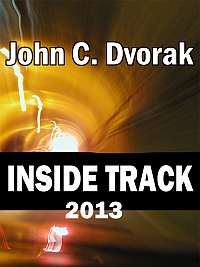
About to be obsolete, again, old friend?
Another in a long line of discoveries that will eventually make multi-terrabyte drives as antiquated as single digit megabyte drives are today. Will they stop when every song, video, book, video game and Britney/Paris/Lindsey photo ever made can fit on a drive and still amazingly have room left over the next version of Windows?
‘Racetrack’ memory could gallop past the hard disk
An experimental breakthrough that could dramatically increase the capacity, speed and reliability of computer hard drives has been announced by an international team of physicists.
Guido Meier at the University of Hamburg in Germany and colleagues used nanosecond pulses of electric current to push magnetic regions along a wire at 110 metres per second – a hundred times faster than was previously possible.
By contrast, today’s hard drives rely on the much slower spinning motion of a disk to move magnetic regions – and the data encoded by these regions – past a component that can change or “read” this magnetic information.
[…]
In his device, a U-shaped magnetic nanowire is embedded into a silicon chip. Magnetic domains are then moved along the wire by pulses of polarised current, and are read by fixed sensors arranged in the silicon itself.According to IBM, this type of magnetic memory could vastly simplify computers, and eventually replace all hard-disk drives.















Of course, there’s 150,000 NA jobs that aren’t required to mass produce, market and service this HD killer.
Before we call this a HD killer… how much data can it store?
Sure sounds like ‘Bubble Memory” or “delay line” technology to me….
The real questions are access times and data density. Disks are extremely dense at this point, but probably can go a bit further before limits kick in. (There’s still no good reason why a 5″ “half-height” form factor couldn’t be used in desktop machines – Lord knows how much data could be stuffed on one of those nowadays. The itty bitty notebook drives aren’t necessarily where it’s at….
What worries most people about spinning memory is mechanical safety, and, at some point, data volatility due to single-bit (or worse) errors due to mechanical issues. (Remember what “Spinrite” was supposed to do?)
Non-rotating material (“solid state”) is probably where it’s going to end up. Some seriously large devices already exist, and even bigger ones are possible….
I’m not sure about the article’s technology – seems like an “overkill” response, and there’s nothing new except perhaps the implementation.
Regards,
Stu.
Having read a lot about the history of computer hardware, this immediately came to mind when I read this article:
“In an acoustic delay line store (“memory”), bits are inserted sequentially into one end of a long metal wire as acoustic pulses, by means of a transducer (see below). These pulses propagate along the wire at the speed of sound, until they arrive at the other end where they are translated back into electrical pulses by another transducer.”
http://www.science.uva.nl/museum/delayline.html
This torsional delay storage was the later version of acoustic delay lines previously made using mercury tubes.
As long as storage prices keep coming down. I just bought a quarter terabyte for $90 and I didn’t even shop! I need lots of storage for all this po… data! Data, that’s it!
There have been a lot of new storage technologies in tech news stories over the past year or two. What most of them have in common is that they’re solid-state. Hard drives have become a lot more reliable (and “Spinrite” is still around, in a much evolved form) but ultimately they still have a lot of moving parts. Quite a few of the new solid-state approaches will no doubt be in use when spinning hard disk technology finally fades.
#4, Bill, thanks for the link.